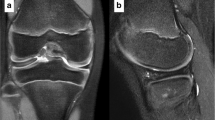Abstract
Objective
To identify preoperative MRI findings in patients with arthroscopically confirmed hypermobile lateral meniscus utilizing a standard MRI knee protocol, with comparison to normal control and lateral meniscal tear groups.
Subjects and methods
All patients with arthroscopically confirmed hypermobile lateral meniscus diagnosed at our institution were retrospectively identified. The following structures were evaluated on preoperative knee MRIs: superior and inferior popliteomeniscal fascicles, lateral meniscus and meniscocapsular junction, popliteal hiatus, and soft tissue edema around the popliteal hiatus. The same MRI features were evaluated in the normal control and lateral meniscal tear groups.
Results
Study, normal control, and lateral meniscal tear patients (18 each) were included. In the study group, 94.4% had superior popliteomeniscal fascicle abnormality, 89.0% had inferior popliteomeniscal fascicle abnormality, and 72.2% had lateral meniscal abnormality. Incidence of these abnormalities was significantly higher than in the normal control group. Meniscal abnormalities in the study group all involved the posterior horn meniscocapsular junction, 12/13 of which had vertical signal abnormality at the junction and 1/13 with anterior subluxation of the entire posterior horn. Popliteus hiatus measurements were largest in the lateral meniscal tear group.
Conclusion
In patients with hypermobile lateral meniscus, the combination of popliteomeniscal fascicle abnormality and vertical signal abnormality at the meniscocapsular junction was seen in the majority of patients. Popliteomeniscal fascicle signal abnormality without identifiable lateral meniscal injury was the next most common imaging appearance. Radiologists may provide valuable information by suggesting the diagnosis of hypermobile lateral meniscus in such cases.




Similar content being viewed by others
References
Beel W, Macchiarola L, Mouton C, Laver L, Seil R. The hypermobile and unstable lateral meniscus: a narrative review of the anatomy, biomechanics, diagnosis and treatment options. Ann Joint. 2022;7(14):1–12.
D’Addona A, Izzo A, Di Vico G, Rosa D, Maffulli N. The popliteomeniscal fascicles: from diagnosis to surgical repair: a systematic review of current literature. J Orthop Surg Res. 2021;16(1):148.
Kamiya T, Suzuki T, Otsubo H, Kuroda M, Matsumura T, Kubota C, et al. Midterm outcomes after arthroscopic surgery for hypermobile lateral meniscus in adults: restriction of paradoxical motion. J Orthop Sci. 2018;23(6):1000–4.
Suganuma J, Mochizuki R, Inoue Y, Yamabe E, Ueda Y, Kanauchi T. Magnetic resonance imaging and arthroscopic findings of the popliteomeniscal fascicles with and without recurrent subluxation of the lateral meniscus. Arthroscopy. 2012;28(4):507–16.
Toyooka S, Shimazaki N, Masuda H, Arai N, Miyamoto W, Ando S, et al. Preoperative magnetic resonance imaging as a diagnostic aid for hypermobile lateral meniscus. Diagnostics (Basel). 2021;11(12):05.
Keyhani S, Movahedinia M, Soleymanha M, Verdonk R, Kazemi M, Qoreishy M. Repair of popliteomeniscal fascicles tear using a posterior transseptal portal fixes hypermobile lateral meniscus. J Exp Orthop. 2021;8(1):93.
LaPrade RF, Konowalchuk BK. Popliteomeniscal fascicle tears causing symptomatic lateral compartment knee pain: diagnosis by the figure-4 test and treatment by open repair. Am J Sports Med. 2005;33(8):1231–6.
Van Steyn MO, Mariscalco MW, Pedroza AD, Smerek J, Kaeding CC, Flanigan DC. The hypermobile lateral meniscus: a retrospective review of presentation, imaging, treatment, and results. Knee Surg Sports Traumatol Arthrosc. 2016;24(5):1555–9.
Ahn JH, Lee SH, Kim KI, Nam J. Arthroscopic meniscus repair for recurrent subluxation of the lateral meniscus. Knee Surg Sports Traumatol Arthrosc. 2018;26(3):787–92.
Shin HK, Lee HS, Lee YK, Bae KC, Cho CH, Lee KJ. Popliteomeniscal fascicle tear: diagnosis and operative technique. Arthrosc Tech. 2012;1(1):e101–6.
Aman ZS, DePhillipo NN, Storaci HW, Moatshe G, Chahla J, Engebretsen L, et al. Quantitative and qualitative assessment of posterolateral meniscal anatomy: defining the popliteal hiatus, popliteomeniscal fascicles, and the lateral meniscotibial ligament. Am J Sports Med. 2019;47(8):1797–803.
Grassi A, Pizza N, Andrea Lucidi G, Macchiarola L, Mosca M, Zaffagnini S. Anatomy, magnetic resonance and arthroscopy of the popliteal hiatus of the knee: normal aspect and pathological conditions. EFORT Open Rev. 2021;6(1):61–74.
Cohn AK, Mains DB. Popliteal hiatus of the lateral meniscus. Anatomy and measurement at dissection of 10 specimens. Am J Sports Med. 1979;7(4):221–6.
Peduto AJ, Nguyen A, Trudell DJ, Resnick DL. Popliteomeniscal fascicles: anatomic considerations using MR arthrography in cadavers. AJR Am J Roentgenol. 2008;190(2):442–8.
Zappia M, Reginelli A, Chianca V, Carfora M, Di Pietto F, Iannella G, et al. MRI of popliteo-meniscal fasciculi of the knee: a pictorial review. Acta Biomed Ateneo Parmense. 2018;89(1-S):7–17.
Li Z, Zhao H, Dai Z, Chen Z, Liao Y, Fu D, et al. Widening of the popliteal hiatus on magnetic resonance imaging leads to recurrent subluxation of the lateral meniscus. Knee Surg Sports Traumatol Arthrosc. 2020;28(11):3532–8.
Sakai H, Sasho T, Wada Y, Sano S, Iwasaki J, Morita F, et al. MRI of the popliteomeniscal fasciculi. AJR Am J Roentgenol. 2006;186(2):460–6.
Author information
Authors and Affiliations
Corresponding author
Ethics declarations
Ethical approval
All procedures performed in studies involving human participants were in accordance with the ethical standards of the institutional and/or national research committee and with the 1964 Helsinki Declaration and its later amendments or comparable ethical standards.
Conflict of interest
Aaron Krych declares consulting and royalties from Arthrex, Inc. All other authors declare that they have no competing interests.
Additional information
Publisher’s note
Springer Nature remains neutral with regard to jurisdictional claims in published maps and institutional affiliations.
Rights and permissions
Springer Nature or its licensor (e.g. a society or other partner) holds exclusive rights to this article under a publishing agreement with the author(s) or other rightsholder(s); author self-archiving of the accepted manuscript version of this article is solely governed by the terms of such publishing agreement and applicable law.
About this article
Cite this article
Heaton, D.J., Collins, M.S., Johnson, A.C. et al. Retrospective evaluation of MRI findings in arthroscopically confirmed cases of hypermobile lateral meniscus. Skeletal Radiol 53, 465–472 (2024). https://doi.org/10.1007/s00256-023-04433-1
Received:
Revised:
Accepted:
Published:
Issue Date:
DOI: https://doi.org/10.1007/s00256-023-04433-1




